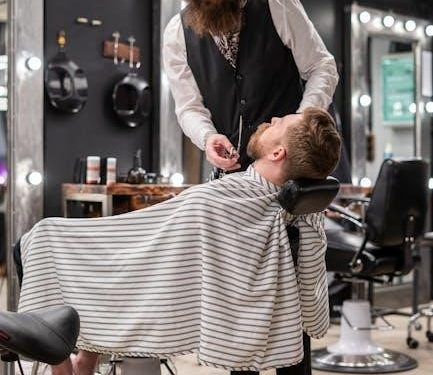Roller shutter doors are versatile, secure, and durable solutions for various applications. Made from horizontal laths and guided by side channels, they offer easy operation and protection.
Components of Roller Shutter Doors
Roller shutter doors consist of horizontal laths, side guides, and a barrel assembly. The 22g lath provides durability, while 65mm guides ensure smooth operation. Key components include bottom rails, endlocks, and bearings for reliable functionality.

2.1. 22g Lath: Specifications and Use
The 22g lath is a key component of roller shutter doors, constructed from galvanized steel with a thickness of 0.7mm. Its durability and resistance to corrosion make it ideal for both commercial and industrial applications. The lath forms the curtain of the shutter, providing strength and stability during operation. It is suitable for manual and electric roller shutter systems, offering a reliable solution for various security and operational needs. The 22g lath is commonly used in settings requiring medium-level security and can be customized with perforations for ventilation and vision, enhancing its functionality. Its widespread use underscores its effectiveness in meeting diverse requirements across different industries.
2.2. 65mm Guides: Features and Functionality
The 65mm guides are essential for the smooth operation of roller shutter doors, ensuring the curtain moves effortlessly up and down. Constructed from galvanized steel, these guides provide durability and resistance to corrosion. They are designed to securely capture the lath curtain, preventing lateral movement and ensuring stable operation. The 65mm guides are suitable for medium to large-sized shutters and are often used in commercial and industrial settings. Their robust design allows them to withstand high wind loads, making them ideal for outdoor applications. Additionally, they can be customized with windlock features for enhanced stability in windy conditions, ensuring long-lasting performance and reliability. The guides are bolted to steel angles, providing a secure and stable framework for the shutter system.

Key Features and Benefits
Roller shutter doors with 22g lath and 65mm guides offer durability, security, and wind resistance. They provide smooth operation, easy maintenance, and enhanced protection for various applications.
3.1. Material Quality and Build
The 22g lath, constructed from high-quality galvanized steel with a thickness of 0.7mm, ensures durability and resistance to corrosion. The 65mm guides, made from robust materials, provide stability and smooth operation, even in demanding conditions. This combination guarantees a sturdy and long-lasting structure, capable of withstanding various environmental factors and heavy use. The materials are carefully selected to ensure minimal maintenance while maintaining optimal performance, making these roller shutter doors a reliable choice for both commercial and industrial settings. The build quality is further enhanced by precise engineering, ensuring seamless functionality and reliability over time.
3.2. Wind Resistance Capabilities
Roller shutter doors with 22g lath and 65mm guides demonstrate excellent wind resistance, making them ideal for areas prone to high winds. The 65mm guide channels provide enhanced structural integrity, ensuring the shutter remains stable under pressure. Windlock guide sections are available for added security in windy locations, preventing misalignment and damage. These shutters are rated to withstand significant wind forces, with certifications like Wind Class Rating 3, ensuring reliability in harsh conditions. The combination of durable materials and robust design ensures minimal sway and optimal performance, making them a practical solution for both commercial and industrial applications requiring strong wind resistance capabilities.
3.3. Enhanced Security Measures
Roller shutter doors incorporating 22g lath and 65mm guides offer exceptional security features. The robust 22g steel lath provides a strong barrier against forced entry, while the 65mm deep guide channels ensure the curtain remains securely in place. Optional windlock guides further enhance protection by preventing the laths from being lifted out of the tracks. Security-rated versions, such as those certified by LPCB level 2, are available for higher-risk applications. These shutters are designed to withstand tampering and forced breaches, making them an excellent choice for commercial and industrial settings requiring high-level security. The combination of durable materials and secure design ensures maximum protection for premises.

Technical Specifications
Roller shutter doors with 22g lath and 65mm guides are constructed from high-quality galvanized steel, ensuring durability and resistance to corrosion. The 22g lath, measuring 0.7mm in thickness, provides a robust curtain, while the 65mm deep guide channels offer stability and smooth operation. These shutters are manufactured in accordance with BS EN 13241-1:2003 and EN 12453:2017 standards, ensuring compliance with safety and performance requirements. The system is CE marked, guaranteeing adherence to European safety norms. With a maximum height of 4500mm and curtain weight of 8kg/m², these doors are suitable for various applications. Wind Class Rating 3 ensures they can withstand high wind loads, making them ideal for both commercial and industrial use.

Installation Considerations
Installing roller shutter doors with 22g lath and 65mm guides requires precise planning and execution. The 65mm guide channels, made from galvanized steel, must be securely bolted to mild steel angles or box sections to ensure stability. Proper alignment of the guides is crucial for smooth operation. The bottom rail, available in single angled designs, must be fitted correctly to prevent misalignment. For windy locations, windlock guide sections are recommended to enhance stability; Additionally, the shutter curtain must be evenly distributed to avoid uneven wear. Professional installation ensures the door operates efficiently and withstands environmental factors like high winds. Regular checks and adjustments are necessary to maintain optimal performance.

Maintenance Tips
Regular maintenance is essential to ensure the longevity and smooth operation of roller shutter doors with 22g lath and 65mm guides. Clean the guide channels periodically to remove dirt and debris that might obstruct movement. Lubricate hinges, bearings, and other moving parts to reduce friction and wear. Inspect the shutter curtain for dents or misalignment and address any issues promptly. Check the bottom rail for obstructions and ensure it is securely fastened. In coastal or high-humidity areas, inspect for rust and apply rust inhibitors as needed. Finally, tighten all fixings and screws regularly to prevent loosening over time. Proper upkeep ensures reliable performance and extends the lifespan of the door.
Applications
Roller shutter doors with 22g lath and 65mm guides are ideal for commercial and industrial settings, including offices, shop fronts, warehouses, car parks, and agricultural buildings.
7.1. Commercial Settings
Roller shutter doors with 22g lath and 65mm guides are widely used in commercial settings, such as retail stores, offices, and serveries. Their durability and security features make them ideal for protecting shop fronts and managing access control. These doors are also commonly installed in car parks and commercial buildings requiring robust entry solutions. The 22g lath provides a balance between strength and affordability, while the 65mm guides ensure smooth operation and stability. Customization options, such as perforated slats for ventilation and vision, further enhance their suitability for diverse commercial environments. Additionally, their low maintenance and ability to withstand harsh weather conditions make them a practical choice for busy commercial spaces.
7.2. Industrial Use Cases
Roller shutter doors with 22g lath and 65mm guides are extensively used in industrial settings due to their durability and ability to withstand heavy-duty operations. These doors are ideal for warehouses, factories, and large industrial facilities where security and reliability are paramount. The 22g lath offers a robust yet lightweight solution, while the 65mm guides provide stability and smooth operation, even in high-traffic environments. They are particularly suited for large openings, such as loading bays, where wind resistance and structural integrity are critical. Customization options, including windlock guides for enhanced stability, make these doors a practical choice for industrial applications requiring strength and versatility. Their ability to meet international safety standards further solidifies their suitability for demanding industrial environments.
Customization Options
Roller shutter doors with 22g lath and 65mm guides offer extensive customization to meet specific requirements. Customers can choose from various guide depths, including 50mm, 65mm, and 100mm, depending on the application. The laths can be perforated or punched for ventilation and visibility, with patterns like Brick-Bond or In-Line. Additionally, doors can be powder-coated in different colors for aesthetic appeal. Windlock guides are available for enhanced stability in windy conditions. The option to customize slat thickness, such as 22g, 20g, or 18g, allows for tailored security and durability. Furthermore, doors can be designed to fit specific sizes and operational needs, ensuring a bespoke solution for industrial, commercial, or residential settings.
Compliance with Standards
Roller shutter doors with 22g lath and 65mm guides are designed to comply with various industry standards. They are CE marked and manufactured in accordance with British Standard BS EN 13241-1:2003 and European Standard EN 12453:2017. These standards ensure that the doors meet rigorous safety, quality, and performance criteria. Additionally, they are tested for wind resistance, security, and operational safety, making them suitable for both commercial and industrial applications. Compliance with these standards ensures that the doors are reliable and safe to operate, providing customers with a product that meets regulatory requirements and industry-accepted benchmarks, thus enhancing overall satisfaction and trust in the product’s durability and performance.

Advantages of 22g Lath and 65mm Guides
The combination of 22g lath and 65mm guides in roller shutter doors offers several advantages. The 22g lath provides a durable yet lightweight curtain, ideal for applications requiring balance between strength and cost-effectiveness. The 65mm guides ensure smooth operation and enhanced stability, particularly in windy conditions, with windlocking options available for added security. This configuration meets European safety standards and is CE marked, ensuring reliability and compliance. Additionally, the 65mm guides accommodate various slat sizes, making the system versatile for different security and operational needs. This setup is also known for its ease of installation and maintenance, making it a popular choice for both commercial and industrial settings. Overall, it delivers a robust, secure, and efficient solution for diverse applications.



















































